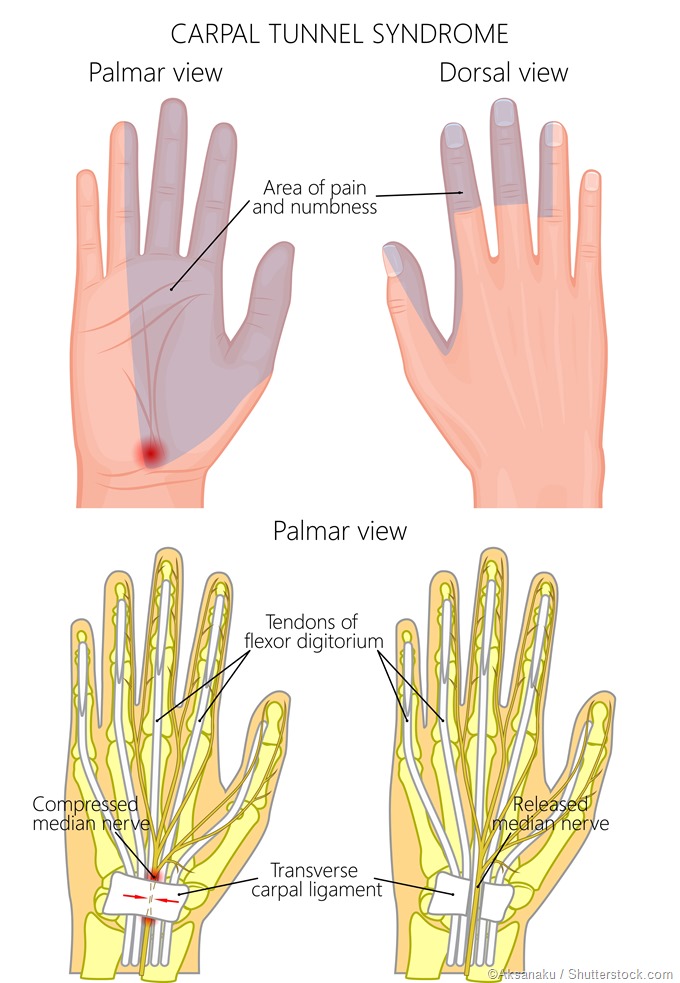‘Pins and needles’ refers to the strange prickling or tingling sensation that comes when an arm or a leg ‘goes to sleep’ because it was pressed against a hard surface for too long, or kept in the same position for a long time. When the position is changed or the pressure relieved, the limb usually feels numb and heavy, followed by pins and needles. The same symptoms can occur in carpal tunnel syndrome, but repeatedly and often accompanied by pain.

Carpal tunnel anatomy
The wrist is a carefully fitted joint made of many small bones held together by strong ligaments, and with the median nerve and muscle tendons passing through the passage in the center. Actually the cavity is towards the inner side of the wrist, and is formed by a strong ligament called the flexor retinaculum, connecting the two ends of the bony arch of carpal bones.
The median nerve is one of the principal nerves responsible for hand and wrist movements, as well as for sensation over much of the hand. It is the most volar and the softest structure in the carpal tunnel, with an average cross-sectional area of 6.19 millimeters.
Causes and prevalence
Swelling of the structures inside the carpal tunnel causes compression of the median nerve, producing nerve symptoms - this is called the carpal tunnel syndrome. The condition is often idiopathic; however, overuse of the joint as by typists or heavy computer users, or routinely having a lot of pressure on the wrist, or twisting movements of the wrist, could damage the tendons and cause swelling. Vibration such as is caused by using vibrating power tools for a long time may also be a cause.
Other conditions include diabetes, rheumatism, trauma to the wrist, or frequent attacks of synovitis. Pregnancy is also a risk factor because of increased tissue edema brought about by physiological changes of pregnancy. It is not clear whether carpal tunnel syndrome is brought about or worsened by these conditions. However, in acute cases, the common causes are trauma, inflammation or hemorrhage into the wrist.
Carpal tunnel syndrome occurs more commonly in women, and those who perform heavy manual labor, especially between the ages of 40 and 70 years. About three in a hundred people report it each year. In many cases, without treatment the hand may become permanently anesthetic, and muscle wasting may occur, making precise jobs difficult to do.
Symptoms
The symptoms of carpal tunnel syndrome may be self-limited, receding in about six months, or may require treatment. They are most common in the night or early morning, and often involve both hands, though at different times. Affected individuals may notice that giving the hand a good shake relieves the symptoms to some degree.
Common symptoms include:
- Numbness over the thumb and the three fingers next to it
- Pins and needles over the same area
- Early on, the individual may notice that the hand tends to develop these symptoms at night
- Pain in the fingers or in the whole hand, or even moving upwards to the arm
Diagnosis and management
Diagnosis is on the basis of symptoms followed by a physical examination, and focal examination of sensation and motor function in hands and wrists. Muscle and nerve testing may be required, as other causes must be ruled out. Ultrasonography and magnetic resonance imaging (MRI) are often pursued as well.
Management is usually by splinting the wrist for mild or moderate symptoms, with avoidance of wrist strain. The underlying cause, if any, must be identified and treated. Ultrasound therapy, manual therapy intervention and ergonomic positioning are also examples of conservative (i.e. non-surgical) treatment approaches.
Intra-articular corticosteroid injections may help with acute pain. Surgical loosening of the carpal tunnel space may be required in some cases where medical treatment is unsuccessful or if nerve integrity is threatened. Alternate medical treatments are also available.
References
- https://www.ncbi.nlm.nih.gov/pubmedhealth/PMH0072783/
- https://www.ncbi.nlm.nih.gov/
- https://www.ncbi.nlm.nih.gov/pmc/articles/PMC4072815/
Further Reading
Last Updated: Dec 29, 2022